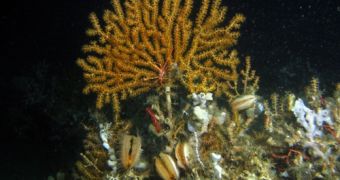A very rare cold water coral reef with living animals has been discovered off the coast of Mauritania in Northern Africa, and this is the first time such a reef has been found so far south, a new report says.
Scientists have found a thriving coral ecosystem in deep cold water, right in the middle of huge rock formation in an undersea canyon.
This coral wall on the continental shelf off the coast of Mauritania measures about 50 to 60 meters (164 to 197 feet) high and is 190 kilometers (118 miles) long.
Normally, cold water coral ecosystems can be found much further north, near Scandinavia and in the Irish Sea, so this is actually the first one that was found so far south, AlphaGalileo reports.
The researchers lowered a robot to the seafloor, 615 m (2,000 feet) underwater, where they discovered amazing animals, like a heavily calcified Lophelia coral with orange-red polyps, and gorgonias coral – a common reef building coral in the tropics.
They also found giant clams hanging on the coral, just in Norwegian reefs.
The difference between cold water corals and tropical corals is that the first ones live at 13 degrees Celsius (55 degrees Fahrenheit), in the dark and nutrient-rich deep sea region below 200 m (650 feet).
André Freiwald, a team member from University of Gothenburg in Sweden, said that the team knew of a loose cold water coral reef which extends to southern regions, but until now, the researchers had only found fossil coral reef structures on the seafloor off the coast of Gibraltar and Morocco.
The powerful carrier crab Paromola and the giant deep sea oyster Neopycnodonte, never before observed so far south, were also found near Mauritania.
These giant oysters form thick populations and can be described as the Methuselah of animals, because there are some that can live for over 500 years.
Finding a cold water coral reef so far south, can be due to the offshore winds pushing the surface waters from the Mauritanian cliffs out into the open ocean, which actually creates a flow of cold and nutrient-rich water to the coral ecosystems, according to Freiwald.
The Maria S. Merian research ship will stop at and chart further parts of the coral ecosystem off the coast of Mauritania, it trip ending November 20.

 14 DAY TRIAL //
14 DAY TRIAL //